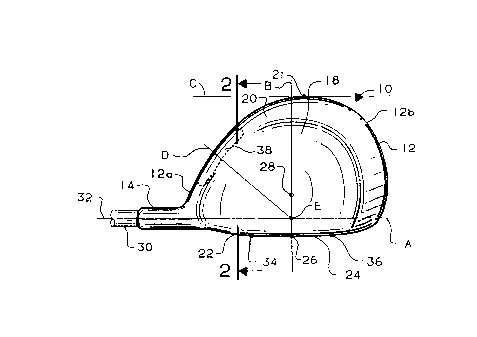Some of the information on this Web page has been provided by external sources. The Government of Canada is not responsible for the accuracy, reliability or currency of the information supplied by external sources. Users wishing to rely upon this information should consult directly with the source of the information. Content provided by external sources is not subject to official languages, privacy and accessibility requirements.
Any discrepancies in the text and image of the Claims and Abstract are due to differing posting times. Text of the Claims and Abstract are posted:
| (12) Patent: | (11) CA 2105830 |
|---|---|
| (54) English Title: | GOLF CLUB HEAD WITH WEIGHT PAD |
| (54) French Title: | TETE DE BATON DE GOLF A MASSE D'EQUILIBRAGE INTERNE |
| Status: | Term Expired - Post Grant Beyond Limit |
| (51) International Patent Classification (IPC): |
|
|---|---|
| (72) Inventors : |
|
| (73) Owners : |
|
| (71) Applicants : |
|
| (74) Agent: | SMART & BIGGAR LP |
| (74) Associate agent: | |
| (45) Issued: | 1997-03-18 |
| (22) Filed Date: | 1993-09-09 |
| (41) Open to Public Inspection: | 1994-09-18 |
| Examination requested: | 1993-10-07 |
| Availability of licence: | N/A |
| Dedicated to the Public: | N/A |
| (25) Language of filing: | English |
| Patent Cooperation Treaty (PCT): | No |
|---|
| (30) Application Priority Data: | ||||||
|---|---|---|---|---|---|---|
|
A golf club head made of a suitable metal such as stainless steel includes a hollow body and a hosel. The hollow body has a top wall, a bottom wall, a side wall, and a front wall with a face arranged for impacting golf balls. The hollow body has a weight pad which provides the golf club head with increased resistance to rotation or twisting upon impact with golf balls at off-center points on the face. The weight pad weighs between 5 and 15 grams and is located in the heel portion of the body. The weight pad is elongated in a direction extending along a length dimension of the body side wall.
Une tête de bâton de golf faite d'un métal adapté tel que l'acier inoxydable comprend un corps creux et un hosel. Le corps creux présente une paroi supérieure, une paroi inférieure, une paroi latérale et une paroi avant avec une face prévue pour frapper des balles de golf. Le corps creux est doté d'une masse d'équilibrage qui offre à la tête de bâton de golf une résistance accrue à la rotation ou à la torsion suite à l'impact avec les balles de golf à des points décentrés points sur la face. La masse d'équilibrage pèse entre 5 et 15 grammes et est située dans la partie talon du corps. La masse d'équilibrage est allongée dans une direction s'étendant le long d'une dimension de longueur de la paroi latérale du corps.
Note: Claims are shown in the official language in which they were submitted.
Note: Descriptions are shown in the official language in which they were submitted.

2024-08-01:As part of the Next Generation Patents (NGP) transition, the Canadian Patents Database (CPD) now contains a more detailed Event History, which replicates the Event Log of our new back-office solution.
Please note that "Inactive:" events refers to events no longer in use in our new back-office solution.
For a clearer understanding of the status of the application/patent presented on this page, the site Disclaimer , as well as the definitions for Patent , Event History , Maintenance Fee and Payment History should be consulted.
| Description | Date |
|---|---|
| Inactive: IPC deactivated | 2017-09-16 |
| Inactive: First IPC assigned | 2016-07-12 |
| Inactive: IPC assigned | 2016-07-12 |
| Inactive: IPC expired | 2015-01-01 |
| Inactive: Expired (new Act pat) | 2013-09-09 |
| Grant by Issuance | 1997-03-18 |
| Application Published (Open to Public Inspection) | 1994-09-18 |
| All Requirements for Examination Determined Compliant | 1993-10-07 |
| Request for Examination Requirements Determined Compliant | 1993-10-07 |
There is no abandonment history.
| Fee Type | Anniversary Year | Due Date | Paid Date |
|---|---|---|---|
| MF (patent, 4th anniv.) - standard | 1997-09-09 | 1997-08-25 | |
| MF (patent, 5th anniv.) - standard | 1998-09-09 | 1998-08-24 | |
| MF (patent, 6th anniv.) - standard | 1999-09-09 | 1999-08-11 | |
| MF (patent, 7th anniv.) - standard | 2000-09-11 | 2000-08-09 | |
| MF (patent, 8th anniv.) - standard | 2001-09-10 | 2001-08-15 | |
| MF (patent, 9th anniv.) - standard | 2002-09-09 | 2002-08-14 | |
| MF (patent, 10th anniv.) - standard | 2003-09-09 | 2003-08-13 | |
| MF (patent, 11th anniv.) - standard | 2004-09-09 | 2004-08-16 | |
| MF (patent, 12th anniv.) - standard | 2005-09-09 | 2005-08-19 | |
| MF (patent, 13th anniv.) - standard | 2006-09-11 | 2006-08-17 | |
| MF (patent, 14th anniv.) - standard | 2007-09-10 | 2007-08-17 | |
| MF (patent, 15th anniv.) - standard | 2008-09-09 | 2008-08-18 | |
| MF (patent, 16th anniv.) - standard | 2009-09-09 | 2009-08-19 | |
| MF (patent, 17th anniv.) - standard | 2010-09-09 | 2010-08-17 | |
| MF (patent, 18th anniv.) - standard | 2011-09-09 | 2011-08-17 | |
| MF (patent, 19th anniv.) - standard | 2012-09-10 | 2012-08-17 |
Note: Records showing the ownership history in alphabetical order.
| Current Owners on Record |
|---|
| KARSTEN MANUFACTURING CORPORATION |
| Past Owners on Record |
|---|
| KARSTEN SOLHEIM |